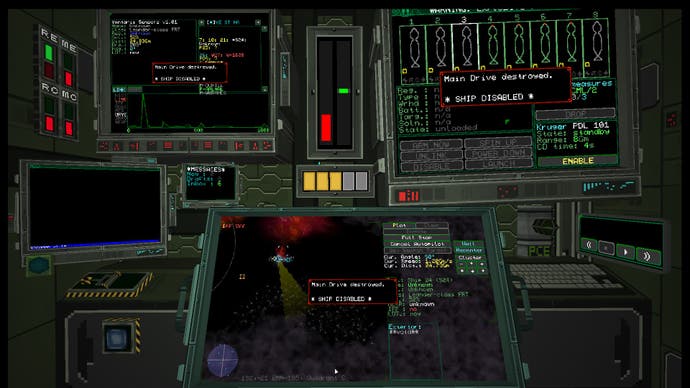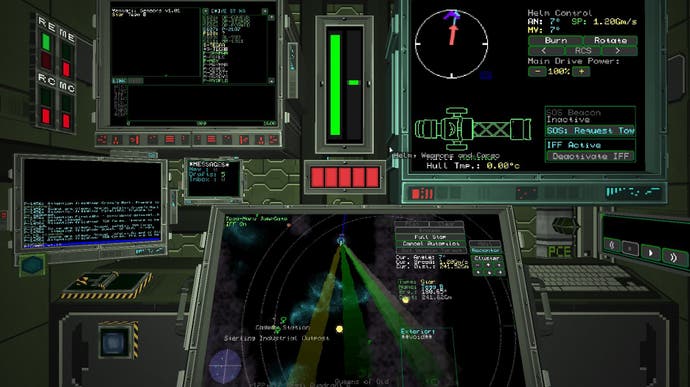Objects in Space and the thrill of interstellar trucking
Modempunk in the trunk.
I love passing the time in Flat Earth's Objects in Space. In fact, I love passing the time in Objects rather more than I love actually achieving things in many other games. An absorbing blend of submarine and space sim distinguished by some decadently throwback interface design, it sees you hauling passengers and cargo across 2D star systems while dodging pirates or indulging in a bit of skyway robbery yourself. These journeys can take upwards of 10 minutes from system jump to system jump, and once you've given the autopilot a heading, there's essentially nothing to do save twiddle your thumbs and luxuriate in the retro ambience of your ship, with its chevron-fringed levers, neon grids and see-saw hum of cooling fans.
You might hop back to your comms room and check your email (best not to do this while the engine is firing, however, as the FTL modem drains power and your reactor can only handle so much in one go - I once managed to paralyse myself by downloading a newsletter in the middle of a braking manoeuvre). You could also turn on the MP3 player for a little light synth, or study the peeling posters in your bunkroom. Or you could click away from the game entirely, leaving it to tick over in another window till a rumble of thrusters indicates that you're approaching your destination. Objects in Space is discreetly composed of tabs, with different parts of your ship (or any space station you're aboard) accessed by hitting right or left arrow. Switching to your computer's desktop feels oddly like a continuation of this: it's as though the very hardware running the game were just another fat nugget of 80s technology, lodged in amongst the raster displays and light-up buttons that comprise your bridge.
Out now in Early Access, Objects in Space lacks the more obvious grandeur of an Elite: Dangerous - there's no 3D galaxy map, no panoramic third-person view, just a spiral of pixel stars through the comms room viewport - but its grubby pocket of space-time feels every bit as lively as Elite's universe, and no less Dangerous. Each system is aswarm with merchant craft, enforcers, military ships, smugglers and banditos, their interactions tracked by your bridge sensors and hailing screen. Eavesdropping on those interactions is another great way of whiling away the longer voyages. As I write these words, the captain of the nearby Pygmy Giant is having a particularly terrible day - fined for possession of contraband just after leaving port, only to fall afoul of a pirate in the shadow of a nebula.
I'm having a few difficulties of my own. There's a question mark icon on my nav display, a couple of million kilometres from my ship - a lazily drifting squiggle of grey, like a serpent in the grass. The ship in question has its Identification Friend or Foe transmitter switched off, which is rather ominous. Also ominous: the spike on my sensor screen's emissions graph. Each ship component in Objects in Space produces gas when in use which make it more perceptible, as represented by a Thief-esque visibility bar in the centre of your bridge. You can gauge an unknown ship's intent by tracking its emissions profile and, conversely, cloak your own movements by disabling your reactor and running on battery power. In this case, the spike corresponds to weapon systems. I disengage the autopilot hurriedly and right on cue, a klaxon sounds. Now there are two signatures on the nav display. The second one is a torpedo, and it's coming right at me.

My homely Ceres Mk-III is neither a lover nor a fighter, but I do have a few tricks up my sleeve. Step one is to drop some countermeasures, luring the torpedo off while I spin the boxy freighter 90 degrees and blast frantically away from my original trajectory. As the bulkheads around me shudder under the stress I kill the engine, open the nav screen again and watch the tiny bundle of death narrowing the gap, second by second. Thankfully, it falls for my countermeasures and zips past, buying me a moment to replenish my power cells and prepare a little welcome package of my own. I lock onto the other ship, or at least its last known position, switch to the weapons screen and spin up a torpedo, its battery drawing energy slowly from my reactor.
Suddenly the icon representing the pirate blinks out... and reappears in a nasty shade of red, within spitting distance of my ship. Whether through the limitations of my own sensors, or by cannily damping his emissions, the enemy pilot has managed to get the jump on me. They're almost near enough now for an exchange of laser fire, which is inconvenient because I don't have any lasers. I do, however, have a half-charged torpedo. I hit the launch button without further ado, and the projectile departs with a muffled slither of metal. A few heart-beats later the helm reports an explosion off the starboard bow and the other ship's icon vanishes, hopefully for good this time. Is it worth going back to check the debris? I'm pondering the odds of salvage when there's an almighty bang on the hull. In my haste to escape the pirate, I've flown straight into an asteroid field. It's at this point that another torpedo appears, right on my tail.

Star-going Dick Turpins and angry space rocks aside, the chief challenge in Objects in Space is working out what the hell everything does. The Early Access build features a short tutorial which communicates the basics of navigation and ship repair; the rest must be gleaned, piece by piece, via certain story missions or conversations with jerkily animated randos at ports. Even if you stick to those story missions, it's easy to lose the thread amid talk of proximity indicators and missile uplinks, cargo pod shielding and hull temperature. The game's commitment to the ramshackle nature of its technology creates an aversion to player convenience: it wants you to jot down things like which spare parts you need to buy or which callsign is which, rather than just laying all the relevant info at your feet. None of this should perturb any veteran of simulations, but if you're after a less trial-and-error-driven, more accessible breed of space exploration I'd probably stick to No Man's Sky.
The big shock with Objects in Space is the wit and detail of its supporting fiction - I was expecting the HUD elements to engross me, but the complexity of its narrative took me off guard. The game unfolds in the aftermath of a half-successful attempt to colonise the far reaches of the galaxy, with the colonists now cut off from Earth and splintered into factions. There are areas of space where socialist fanatics hold sway, areas of space locked in the kung-fu-grip of corporate interest and uncharted sectors where the most vicious pirates lurk. Thus far, the missions, backstory artefacts and conversation trees do a good job of digging into all this social texture. I've smuggled terrorists out of core systems, acted as go-between for drug dealers (and ratted on them afterwards) and helped a bright young thing pursue her dream of being a professional anti-gravity athlete.

It's a realm of some drama, but all of the drama is pegged down by the quiet gratification of keeping your own rickety vessel in trim, your growing familiarity with its rhythms and foibles. Objects is kind of like the part in Alien before the arrival of the Alien - a romanticising of the loneliness of the long haul trucker, fed through the prisms of various engagingly unwieldy spacecraft. I've barely cracked the lid on the game, but it's already a space I want to hang out in, both for the suspense and paranoia of its combat and those moments of strangely captivating idleness when the autopilot is on, the darkness around me is calm and I'm left to my own devices.


